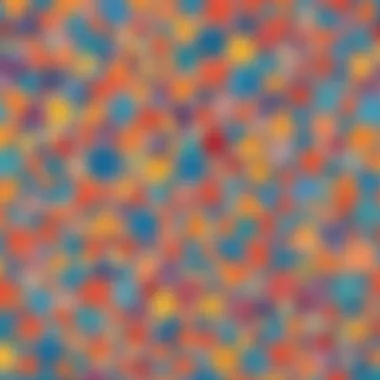Embark on a Fascinating Journey Through Basic Geometry Concepts for Elementary School Children


Creative Activities
Rediscovering Basic Geometrical Concepts for School Children is an electrifying adventure into the world of geometry, carefully tailored to capture the imaginations of young minds. Imprinting foundational principles in an approachable manner sets the stage for exploration and understanding. By delving into shapes, angles, and measurements through engaging activities, children embark on a journey enriched with creativity and knowledge.
Craft Ideas:
Introducing children to shapes through hands-on activities can solidify their grasp of basic geometrical concepts. Crafting simple shapes using everyday materials sparks curiosity and allows for tactile learning experiences. From constructing triangles with popsicle sticks to tracing circles on cardboard, these activities instill practical knowledge in a fun and interactive way.
Step-by-Step Guides:
Providing clear, step-by-step instructions for each craft activity ensures that children can easily follow along and replicate the projects with minimal assistance. Sequential guidance aids in building children's confidence while enhancing their understanding of geometrical concepts. Breaking down complex shapes into manageable steps fosters a sense of accomplishment and encourages further exploration.
Educational Value:
Beyond fostering creativity, engaging in craft activities holds immense educational value. By merging art with geometry, children develop spatial awareness, fine motor skills, and cognitive abilities. These activities lay a solid foundation for future mathematical concepts while promoting a holistic approach to learning.
Fun Quizzes
Fact-Based Articles
Introduction to Geometry
Geometry is a fundamental concept that plays a crucial role in shaping our understanding of the world around us. In this article, we will embark on a journey to explore the basic principles of geometry. By introducing elementary school children to geometric concepts, we lay a strong foundation for their future mathematical learning. Understanding shapes, angles, and measurements not only aids in academic growth but also enhances logical reasoning and problem-solving skills.
Defining Geometry
Basic understanding of geometry
Geometry, at its core, deals with the properties and relationships of shapes and spaces. By introducing children to basic geometry, we equip them with the tools to analyze and describe various figures accurately. Understanding geometric principles helps children perceive the world with more precision and clarity. It fosters spatial awareness and enhances their visual acuity, laying a solid groundwork for advanced mathematical concepts later on.


Impotence of geometry in everyday life
The application of geometry in everyday life is vast and multifaceted. From designing buildings to planning routes, geometry plays a vital role in numerous real-world scenarios. By recognizing the importance of geometry, children develop a practical mindset and learn to appreciate the relevance of mathematics in the world around them. Understanding geometry empowers children to solve practical problems efficiently and fosters a deeper appreciation for the beauty of geometric patterns in nature and man-made structures.
Types of Shapes
Introduction to 2D shapes
Introducing children to two-dimensional shapes lays the groundwork for understanding spatial relationships. By learning about shapes such as squares, circles, and triangles, children develop the ability to visualize and identify different forms. Understanding 2D shapes helps in distinguishing between figures based on their properties like sides and angles, fostering a more structured approach to geometry.
Exploring 3D shapes
Delving into the realm of three-dimensional shapes introduces children to the concept of depth and volume. By exploring shapes like cubes, spheres, and pyramids, children expand their spatial reasoning skills. Understanding 3D shapes enables children to visualize objects in a more realistic manner and enhances their ability to manipulate and understand the physical world in a more comprehensive way.
Elements of Shapes
In this section, we delve into the fundamental aspects of shapes in the context of elementary school education. Understanding shapes is pivotal in the study of geometry as they form the basic building blocks of the subject. By familiarizing children with different shapes, we lay a solid foundation for more complex geometric concepts. The benefit of introducing elements of shapes early on is that it cultivates spatial awareness and visual recognition skills. This section aims to nurture children's perception of the world around them through geometric shapes by fostering a keen eye for detail and structure.
Lines and Line Segments
Differentiating lines and line segments
The distinction between lines and line segments is crucial in geometry and plays a significant role in this educational article. By clarifying the difference between these two concepts, we provide children with a clear framework for understanding spatial relationships. Differentiating lines and line segments helps in honing logical reasoning skills as children learn to identify continuous versus segmented entities. This knowledge aids in later geometry studies where precision and accuracy are paramount. Understanding the nuances of lines and line segments serves as a cornerstone for grasping more complex geometric ideas.
Understanding rays and angles
The comprehension of rays and angles adds another layer of depth to the exploration of geometry in the context of elementary education. Rays are essential geometric elements that emanate from a single point indefinitely in one direction, setting the stage for understanding angles. By introducing children to rays and angles, we equip them with the tools to comprehend spatial orientation and directional concepts. Understanding rays and angles offers a practical application of geometry in real-world scenarios, enhancing problem-solving skills and critical thinking abilities. This section paves the way for a more comprehensive exploration of geometric principles in a systematic and engaging manner.
Angles and Their Types


Acute, obtuse, and right angles
The categorization of angles into acute, obtuse, and right angles is a fundamental aspect of geometry education for elementary school children. By exploring these angle types, we enable students to distinguish between different angular measurements and understand their geometric significance. Acute angles, obtuse angles, and right angles each have distinct characteristics that influence shapes and spatial relationships. By delving into these angle types, children develop an appreciation for the inherent geometry present in everyday objects and structures. This knowledge serves as a scaffold for more advanced geometry topics, facilitating a seamless progression in geometric learning.
Exploration of straight angles
The exploration of straight angles introduces children to a fundamental concept in geometry that lays the groundwork for understanding angular relationships. Straight angles measure 180 degrees and represent a complete rotation around a point. By exploring straight angles, students gain insight into the concept of linearity and the interconnectedness of geometric elements in various shapes. Understanding straight angles enhances children's spatial reasoning abilities and enables them to visualize geometric configurations accurately. This section provides a solid foundation for comprehending more intricate geometric properties and transformations, setting the stage for a comprehensive exploration of geometry's versatile principles.
Measurement in Geometry
In the vast expanse of geometrical knowledge, the realm of Measurement in Geometry stands as a crucial cornerstone. For elementary school children embarking on their geometric journey, grasping the concepts of length, perimeter, area, and volume is paramount. Understanding these fundamental measurements provides a solid foundation for higher-level geometric explorations. Through the lens of Measurement in Geometry, young minds can comprehend and quantify the shapes that surround them, enabling them to analyze and evaluate spatial dimensions with precision. This section will delve into the significance of measurement within the geometric world, shedding light on how these measurements form the building blocks of spatial reasoning.
Length and Perimeter
Understanding length measurements
One of the fundamental aspects of Measurement in Geometry revolves around understanding length measurements. By comprehending lengths, children can distinguish between objects' sizes and establish comparisons based on quantitative values. The ability to measure length not only aids in spatial awareness but also fosters a deeper understanding of size relationships. Through activities such as measuring objects with rulers or tapes, students develop crucial skills in estimation and precision. The application of length measurements serves as a gateway to exploring more complex geometric concepts, laying a sturdy groundwork for future mathematical endeavors. While mastering length measurements may seem simplistic, its implications extend far and wide, guiding learners towards sharper spatial cognition.
Calculation of perimeters
Another pivotal aspect of geometric measurement is the calculation of perimeters. The perimeter of a shape refers to the sum of its side lengths, encapsulating the entirety of its boundary. Understanding how to calculate perimeters equips students with the ability to assess and compare shapes based on their outer dimensions. By engaging in perimeter calculations, children not only sharpen their arithmetic skills but also cultivate a keen eye for detail and accuracy. Perimeter calculations provide a tangible way for students to practice addition and multiplication while reinforcing their spatial reasoning abilities. The concept of perimeters adds a layer of depth to geometric explorations, offering a practical application of measurement concepts within the realm of shape analysis.
Area and Its Concepts
Introduction to area measurement
At the crux of geometric measurement lies the concept of area, a fundamental metric that encapsulates the extent of a two-dimensional shape's surface. Introducing children to area measurement opens avenues for understanding spatial coverage and quantifying regions occupied by various shapes. By familiarizing themselves with area measurement, young learners develop a holistic view of how space can be quantified and compared. The concept of area serves as a bridge between linear measurements and spatial occupation, unlocking a deeper comprehension of shape configurations. Through interactive exercises and real-world applications, students can internalize the significance of area measurement and apply it to analyze shapes prevalent in their surroundings.
Calculating areas of basic shapes


A crucial facet of geometric exploration involves calculating the areas of basic shapes. From squares to circles, triangles to rectangles, understanding how to determine the area of these foundational shapes is essential for geometry comprehension. By mastering the art of calculating areas, students can discern the spatial extent covered by different shapes and make informed comparisons based on their area values. The ability to calculate areas instills problem-solving skills, as learners must apply geometric formulas and logical reasoning to arrive at accurate results. Exploring the intricacies of area calculations not only enhances mathematical proficiency but also cultivates a profound appreciation for the governing principles of spatial measurement. By unraveling the mysteries of area calculation, children can unlock the secrets hidden within geometric shapes and unravel the tapestry of spatial dimensions.
Geometrical Transformations
Geometrical transformations play a crucial role in shaping young minds' understanding of spatial relationships. In this section, we will delve into the importance of these transformations within the realm of elementary school geometry education. By exploring reflection, symmetry, translation, and rotation, children can grasp the dynamic nature of geometric shapes and structures. Understanding how shapes change in space is fundamental to unlocking more complex concepts in geometry. Through interactive activities and visual aids, students can deepen their comprehension and visualization skills.
Reflection and Symmetry
Understanding reflection in shapes
The concept of reflection in shapes introduces children to the notion of mirroring. By learning how shapes reflect across a line, students develop an appreciation for symmetry and balance in geometry. Reflection enhances spatial awareness and encourages critical thinking as youngsters observe identical shapes on opposite sides of the mirror line. This interactive approach fosters an intuitive understanding of geometric transformations and lays the foundation for more intricate geometrical studies.
Exploring symmetry
Symmetry captivates young learners by showcasing harmony and equilibrium in shapes. Through exploration, children uncover the beauty of symmetrical patterns and gain insight into the balance inherent in geometric figures. Understanding symmetry nurtures artistic sensibilities and cultivates an eye for detail, essential in geometry. By recognizing symmetrical properties in everyday objects, students hone their analytical skills and appreciate the uniformity present in nature, architecture, and design.
Translation and Rotation
Concept of translating shapes
Translating shapes involves moving them from one position to another without altering their orientation. This concept introduces children to the idea of shifting objects while maintaining their original shape and size. By exploring translations, students develop spatial reasoning and recognize patterns in positional changes. This fundamental skill lays the groundwork for understanding more advanced geometric transformations and paves the way for systematic problem-solving.
Rotation angles
Rotating shapes introduces children to the concept of turning objects around a point. By exploring rotation angles, students gain insight into how shapes can be repositioned while preserving their form. Understanding rotation enhances visual perception and strengthens mental agility as learners manipulate shapes in varying directions. This hands-on approach instills a sense of flexibility and creativity in problem-solving, empowering students to visualize transformations in a three-dimensional space with precision.
Conclusion
Recap of Geometrical Concepts
Highlighting key learnings
Highlighting key learnings plays a pivotal role in reinforcing the fundamental principles of geometry introduced in the article. By emphasizing the critical aspects of shapes, angles, and measurements, it helps solidify the understanding of geometric concepts in young minds. The key characteristic of highlighting key learnings lies in its ability to simplify complex ideas into digestible nuggets of information, making it easier for elementary school children to retain and apply geometric knowledge. This approach proves beneficial as it ensures that the essential takeaways are highlighted effectively, enhancing the overall learning experience for the target audience.
Encouraging further exploration
Encouraging further exploration serves as a catalyst for promoting curiosity and inquiry among young learners regarding geometrical concepts. By encouraging students to delve deeper into the world of geometry beyond the basics covered in the article, it fosters a spirit of discovery and critical thinking. The key characteristic of encouraging further exploration lies in its ability to instill a sense of creativity and fascination with geometric shapes and patterns, motivating children to explore mathematical concepts independently. This approach proves advantageous by sparking an ongoing interest in geometry, leading to continued growth and development in mathematical aptitude for the target audience.







